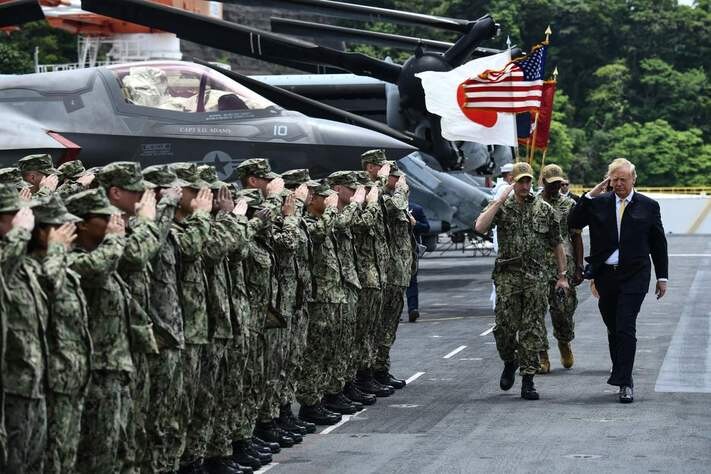hankyoreh
Links to other country sites 다른 나라 사이트 링크
[Editorial] Japan should reflect on its past before expanding its military capability

On May 28, the leaders of Japan and the US highlighted their “global alliance” by boarding the JS Kaga, a Japanese helicopter destroyer that’s slated to be retrofitted as Japan’s first aircraft carrier since World War II. The event is taken as symbolic evidence that the two leaders are in agreement about the Japan Self-Defense Force (JSDF) taking a bigger part in military activities in the Indo-Pacific region, alongside the US military.
This effectively spells the end of Japan’s principle of an exclusively defense-oriented military, which had been the foundation of Japan’s postwar security, with the effect of making Japan’s neighbors more uneasy and putting them on their guard. We feel compelled to voice our strong concern about Japan’s effort to increase its military role without adequately reckoning with its militarism and wars of aggression in the previous century. It’s also unfortunate that US President Donald Trump appears to be publicly backing Japan’s attempts to return to its former military strength.
Abe said that the Japan-US alliance “must make the Indo-Pacific a free and open place and must become the cornerstone for regional peace and prosperity.” This was an overt expression of Abe’s intention for the JSDF to expand its scope of activity under the cloak of the Japan-US alliance. Abe also said that the JS Kaga would be “retrofitted and outfitted with STOVL [short takeoff and vertical landing] aircraft so that it can contribute even more to the peace and stability of the country and the region,” unveiling a plan to expand Japan’s ability to carry out operations over a long distance.
Trump responded by saying that “the JS Kaga will help our nations defend against a range of complex threats in the region and far beyond,” basically approving of the JSDF taking on a stronger role.
Since the 1980s, Japan has repeatedly pushed to expand the JSDF’s role and the scope of its activity. That has been especially true since Abe became prime minister in December 2012. Under Abe, Japan has offered a new constitutional interpretation that authorizes the formerly rejected “right to collective self-defense” and has radically expanded the JSDF’s operational scope through another revision of the Guidelines for Japan-US Defense Cooperation.
That has paved the way for plans to acquire considerable military assets, including aircraft carriers, F-35 stealth fighters, precision guided air-to-ground cruise missiles called JASSM, and air-to-ship cruise missiles called LRASM. Those are all offensive weapons designed to destroy enemy bases, which is a far cry from Japan’s principle of an exclusively defense-oriented military.
Japan’s ambitions of becoming a major military power are being reinforced by the US, which sees them as coinciding with its strategic intention of checking the rise of China. But that’s likely to provoke China into further expanding its military and to push South Korean public opinion toward doing the same, potentially kicking off an arms race in Northeast Asia. Before Japan becomes a “normal country that is capable of waging war,” it needs to engage in some agonizing soul-searching about its past aggression and make an apology.
Please direct comments or questions to [english@hani.co.kr]

Editorial・opinion
![[Column] Park Geun-hye déjà vu in Yoon Suk-yeol [Column] Park Geun-hye déjà vu in Yoon Suk-yeol](https://flexible.img.hani.co.kr/flexible/normal/500/300/imgdb/original/2024/0424/651713945113788.jpg) [Column] Park Geun-hye déjà vu in Yoon Suk-yeol
[Column] Park Geun-hye déjà vu in Yoon Suk-yeol![[Editorial] New weight of N. Korea’s nuclear threats makes dialogue all the more urgent [Editorial] New weight of N. Korea’s nuclear threats makes dialogue all the more urgent](https://flexible.img.hani.co.kr/flexible/normal/500/300/imgdb/original/2024/0424/7317139454662664.jpg) [Editorial] New weight of N. Korea’s nuclear threats makes dialogue all the more urgent
[Editorial] New weight of N. Korea’s nuclear threats makes dialogue all the more urgent- [Guest essay] The real reason Korea’s new right wants to dub Rhee a founding father
- [Column] ‘Choson’: Is it time we start referring to N. Korea in its own terms?
- [Editorial] Japan’s rewriting of history with Korea has gone too far
- [Column] The president’s questionable capacity for dialogue
- [Column] Are chaebol firms just pizza pies for families to divvy up as they please?
- [Column] Has Korea, too, crossed the Rubicon on China?
- [Correspondent’s column] In Japan’s alliance with US, echoes of its past alliances with UK
- [Editorial] Does Yoon think the Korean public is wrong?
Most viewed articles
- 1‘We must say no’: Seoul defense chief on Korean, USFK involvement in hypothetical Taiwan crisis
- 2N. Korean delegation’s trip to Iran shows how Pyongyang is leveraging ties with Moscow
- 3Amnesty notes ‘erosion’ of freedom of expression in Korea in annual human rights report
- 4‘Weddingflation’ breaks the bank for Korean couples-to-be
- 5[Reportage] On US campuses, student risk arrest as they call for divestment from Israel
- 6[Column] Park Geun-hye déjà vu in Yoon Suk-yeol
- 7Korea sees more deaths than births for 52nd consecutive month in February
- 8Will NewJeans end up collateral damage in internal feud at K-pop juggernaut Hybe?
- 9[Guest essay] The real reason Korea’s new right wants to dub Rhee a founding father
- 10[Editorial] New weight of N. Korea’s nuclear threats makes dialogue all the more urgent